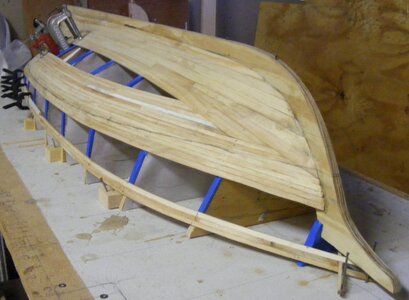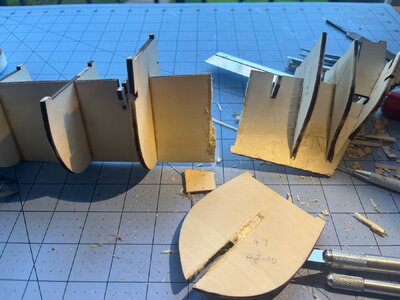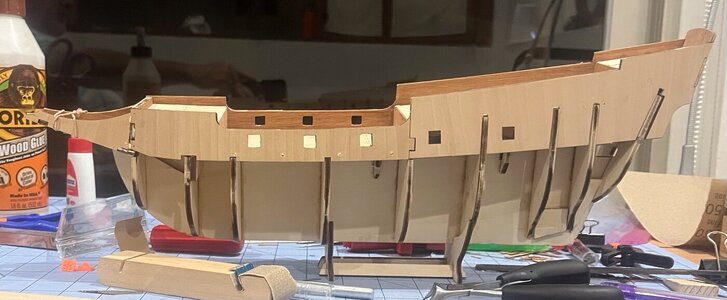You are using an out of date browser. It may not display this or other websites correctly.
You should upgrade or use an alternative browser.
You should upgrade or use an alternative browser.
I have managed to recover 6 out of the 7 small parts which have fallen through the deck hatch into the hull. That's a better than average score. Yes, it's frustrating enough to keep count. However, the brown carpet claims 15% of all the blocks and belaying pins dropped onto it. Carpet wins.I'm convinced small parts fall into another dimension!

What if you don’t fight this and build an old model from the beginning, as V. Zhdan doesMy models always seem to achieve that beaten, weathered appearance through lack of skill and experience in wood finishing and simple sloppy painting and workmanship!
Control of the amount of glue used per application and excess glue cleanup while working is something beginners often lack, and being able to paint with a steady hand along edges. I still wrestle with that.
Another mistake is not knowing the proper use of CA glue. Two major mistakes: first is using the wrong viscosity for the task. Beginners try using CA thin for everything when CA thick or gel is the correct viscosity. Second is using too much CA. Less is way better when it comes to CA.
Yes, there is a parallel universe - in fact a specific planet- where all the lost springs, widgets, thingees and other small stuff goes.I'm convinced small parts fall into another dimension!
Because starting with the weather approach, and adding all the scrapes, scratches, wandering paint lines, and less than decent finish would make it far worse?What if you don’t fight this and build an old model from the beginning, as V. Zhdan does? But you also need to be able to do this and try to do everything correctly. But this is already a separate art.

There are modelers on this forum such as shelk in Portugal who have mastered the art of weathering a ship using multiple layers of paint combined with paint chipping techniques (Build log). Weathering on that level awes me.
I think one of the biggest mistakes is forgetting that this is a hobby... not a competition (mostly). I'll never reach the heights of some of our fabulous modelers but I do marvel at the workmanship. Instead, I enjoy my builds with mistakes, errors, and blemishes and think about building the next one.
Another mistake by beginners…not paying attention and keeping to scale. I think keeping model kit pieces parts in scale is difficult for most every modeler but those new to the hobby have a difficult time understanding the scale of the model. Easy example is the ring bolts we stick on the decks…we use what we can get for premade ring bolts but they are most often too large to scale. But other examples are spars that are too thick and deck treenails that are way too large to scale. Those new to the hobby learn the impact of parts out of scale…it is always better to go small rather than large. Trust your eye…we can often discern by eye when something doesn’t look right!
Last edited:
Absolutely! I drop parts and I hear them hit and bounce but I never find them! So somewhere there is enough parts to build another ship model…but darn if I can find them!Yes, there is a parallel universe - in fact a specific planet- where all the lost springs, widgets, thingees and other small stuff goes.
Kurt Konrath
Kurt Konrath
One big lesson I learned is to keep a bottle of CA de-bonder handy when using CA, for fingers sake....I thought frustration and this hobby go hand in hand. BUT, then something goes right, looks good and satisfaction comes into play. So you carry on building.
Like a golfer always trying for that hole in one.... maybe next time....
Biggest thing I've learned, know where, when and how much CA to use.
If only brass was magnetic.....Oh wait on.Yes, there is a parallel universe - in fact a specific planet- where all the lost springs, widgets, thingees and other small stuff goes.
One last mistake by beginners…not paying attention and keeping to scale. I think keeping model kit pieces parts in scale is difficult for most every modeler but those new to the hobby have a difficult time understanding the scale of the model. Easy example is the ring bolts we stick on the decks…we use what we can get for premade ring bolts but they are most often too large to scale. But other examples are spars that are too thick and deck treenails that are way too large to scale. Those new to the hobby learn the impact of parts out of scale…it is always better to go small rather than large. Trust your eye…we can often discern by eye when something doesn’t look right!
I do get this from a purist point of view. I always try to "think in scale" whenever working on a model, and I'm never without a calculator around the bench for ciphering sizes, especially doing scratch work. But... there's always the compromise that sometimes things do need to be a little out of scale for visual appeal.
Setup your work area so small parts have no where to hide. Also keep kit parts in their original packaged form right up until they are needed or discard the plastic tray small parts come in and use containers with a snap locking seal( I use pill reminder cases). An ounce of prevention is worth a pound of cure (learned the hard way)
I don't take issue with goofy planking patterns, which isn't something limited to "novices" by-the-way. It's when they insist on finishing the hull bright (varnish) to show off all that pretty wood AND their goofy planking. If you're not gonna plank correctly, PAINT.


The examples above are my own model, and I should have painted inside the hull, because seeing that planking bothers me to no end..


The examples above are my own model, and I should have painted inside the hull, because seeing that planking bothers me to no end..
By the way…I have been contributing to this string from my own experiences of the mistakes I made and learned from. A rigging mistake is not allowing enough thread to work the rigging…beginners think they need to conserve thread so they only give themselves an extra inch or two of thread to rig and belay. Short thread makes it very difficult to complete a belay. Give yourself several extra inches to work with…you will think you are wasting thread when you accumulate a pile of clipped ends but a pile of clipped ends are worth reducing the frustration factor of trying to wrap an inch of rigging line around a belay point.
Last edited:
Or when one needs to use parts that are available but are really out of scale…eye bolts being typical. We use what we have, what the market offers us, and compromise scale…I do get this from a purist point of view. I always try to "think in scale" whenever working on a model, and I'm never without a calculator around the bench for ciphering sizes, especially doing scratch work. But... there's always the compromise that sometimes things do need to be a little out of scale for visual appeal.
Last edited:
- Joined
- Feb 28, 2022
- Messages
- 100
- Points
- 58

I think this is the best advice… Works well as career advice too...Done this many, many times, but I can’t tell you how many of those times have been a double-edge sword. Get flustered by something, walk away for a week or two, then when you get in the mind to get back to the bench, it was a 15 minute fix… now pissed at myself for letting it get to me and miss out on two weeks of build time.
OUCH!My biggest mistake is/was not being patient. Take your time.
View attachment 429053
On the bright side, I also learned that most wooden accidents can be corrected.
View attachment 429055
Glad you were able to fix it. It looks great.
Last edited:








